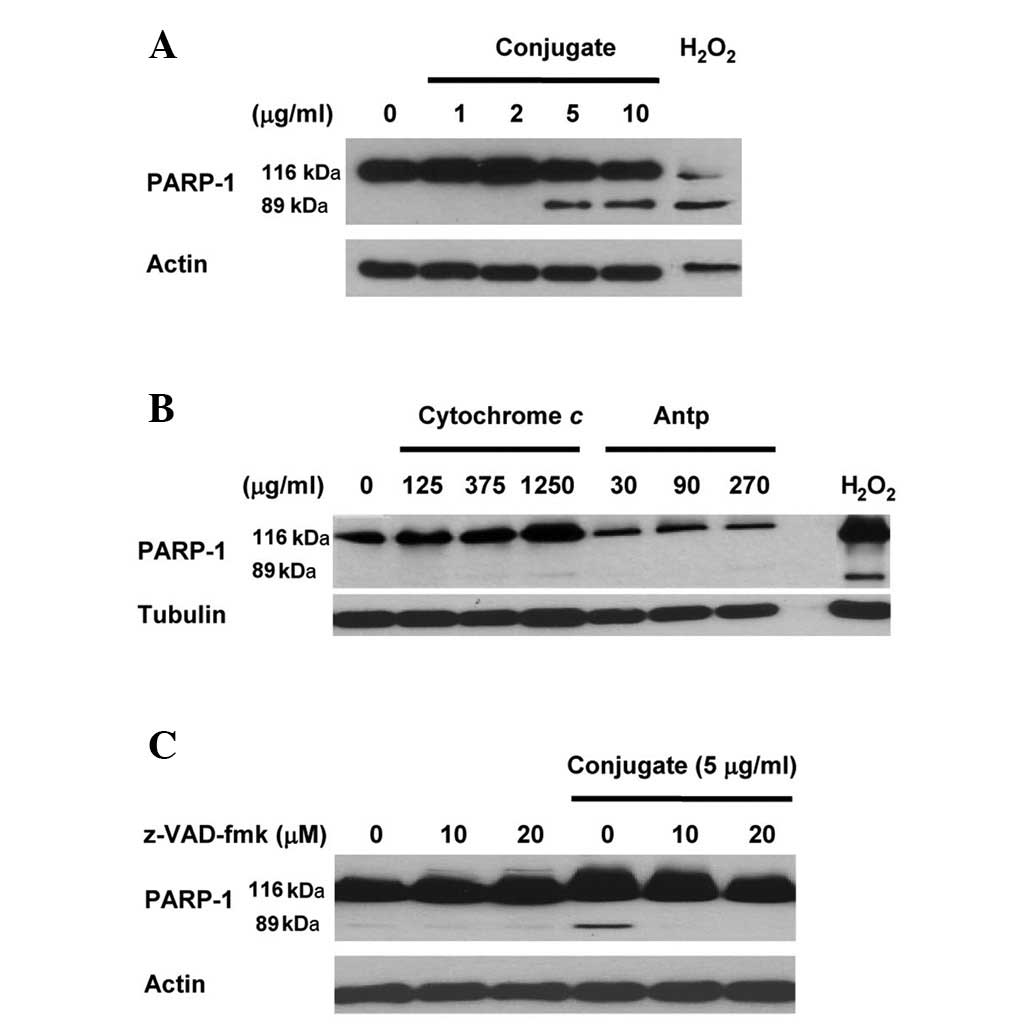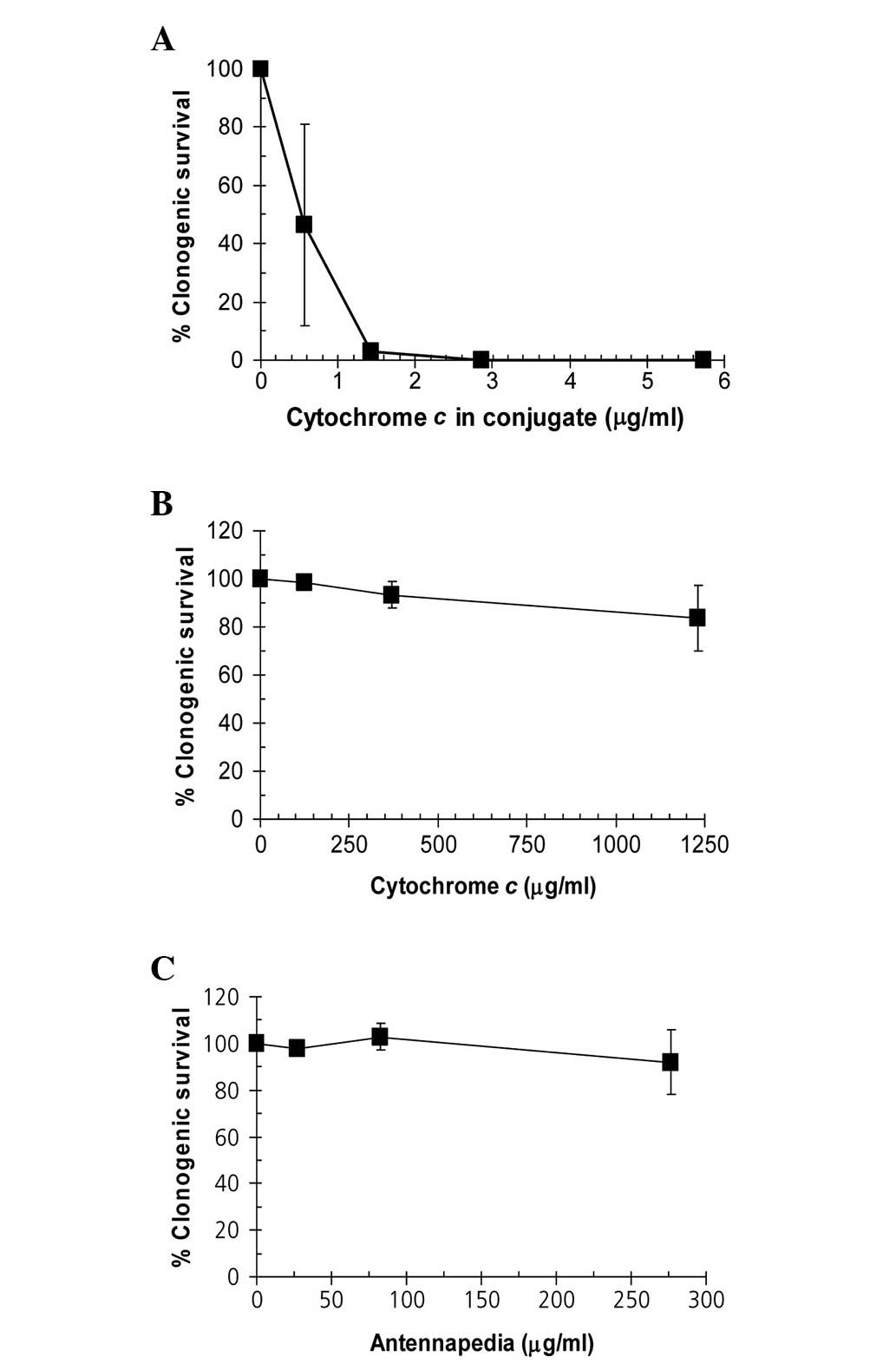|
1
|
Green DR and Kroemer G: The
pathophysiology of mitochondrial cell death. Science. 305:626–629.
2004. View Article : Google Scholar : PubMed/NCBI
|
|
2
|
Schafer ZT and Kornbluth S: The
apoptosome: physiological, developmental, and pathological modes of
regulation. Dev Cell. 10:549–561. 2006. View Article : Google Scholar : PubMed/NCBI
|
|
3
|
Riedl SJ and Salvesen GS: The apoptosome:
signalling platform of cell death. Nat Rev Mol Cell Biol.
8:405–413. 2007. View
Article : Google Scholar : PubMed/NCBI
|
|
4
|
Ow YL, Green DR, Hao Z and Mak TW:
Cytochrome c: functions beyond respiration. Nat Rev Mol Cell
Biol. 9:532–542. 2008.
|
|
5
|
Peter ME and Krammer PH: The
CD95(APO-1/Fas) DISC and beyond. Cell Death Differ. 10:26–35. 2003.
View Article : Google Scholar : PubMed/NCBI
|
|
6
|
Li F, Srinivasan A, Wang Y, Armstrong RC,
Tomaselli KJ and Fritz LC: Cell-specific induction of apoptosis by
microinjection of cytochrome c. Bcl-xL has activity
independent of cytochrome c release. J Biol Chem. 272:30299–30305.
1997. View Article : Google Scholar : PubMed/NCBI
|
|
7
|
Zhivotovsky B, Orrenius S, Brustugun OT
and Døskeland SO: Injected cytochrome c induces apoptosis.
Nature. 391:449–450. 1998. View
Article : Google Scholar : PubMed/NCBI
|
|
8
|
Gabriel B, Sureau F, Casselyn M, Teissié J
and Petit PX: Retroactive pathway involving mitochondria in
electroloaded cytochrome c-induced apoptosis. Protective
properties of Bcl-2 and Bcl-XL. Exp Cell Res. 289:195–210. 2003.
View Article : Google Scholar : PubMed/NCBI
|
|
9
|
Kam NW and Dai H: Carbon nanotubes as
intracellular protein transporters: generality and biological
functionality. J Am Chem Soc. 127:6021–6026. 2005. View Article : Google Scholar : PubMed/NCBI
|
|
10
|
Frauke Pistel K, Breitenbach A,
Zange-Volland R and Kissel T: Brush-like branched biodegradable
polyesters, part III. Protein release from microspheres of
poly(vinyl alcohol)-graft-poly (D,L-lactic-co-glycolic acid). J
Control Release. 73:7–20. 2001.PubMed/NCBI
|
|
11
|
Temsamani J and Vidal P: The use of
cell-penetrating peptides for drug delivery. Drug Discov Today.
9:1012–1019. 2004. View Article : Google Scholar : PubMed/NCBI
|
|
12
|
Zorko M and Langel U: Cell-penetrating
peptides: mechanism and kinetics of cargo delivery. Adv Drug Deliv
Rev. 57:529–545. 2005. View Article : Google Scholar : PubMed/NCBI
|
|
13
|
Mäe M and Langel U: Cell-penetrating
peptides as vectors for peptide, protein and oligonucleotide
delivery. Curr Opin Pharmacol. 6:509–514. 2006.PubMed/NCBI
|
|
14
|
Howl J, Nicholl ID and Jones S: The many
futures for cell-penetrating peptides: how soon is now? Biochem Soc
Trans. 35:767–769. 2007. View Article : Google Scholar : PubMed/NCBI
|
|
15
|
Aroui S, Ram N, Appaix F, Ronjat M, Kenani
A, Pirollet F and De Waard M: Maurocalcine as a non toxic drug
carrier overcomes doxorubicin resistance in the cancer cell line
MDA-MB 231. Pharm Res. 26:836–845. 2009. View Article : Google Scholar : PubMed/NCBI
|
|
16
|
Perez F, Joliot A, Bloch-Gallego E,
Zahraoui A, Triller A and Prochiantz A: Antennapedia homeobox as a
signal for the cellular internalization and nuclear addressing of a
small exogenous peptide. J Cell Sci. 102:717–722. 1992.PubMed/NCBI
|
|
17
|
Derossi D, Joliot AH, Chassaing G and
Prochiantz A: The third helix of the Antennapedia homeodomain
translocates through biological membranes. J Biol Chem.
269:10444–10450. 1994.PubMed/NCBI
|
|
18
|
Diekert K, de Kroon AI, Ahting U,
Niggemeyer B, Neupert W, de Kruijff B and Lill R: Apocytochrome
c requires the TOM complex for translocation across the
mitochondrial outer membrane. EMBO J. 20:5626–5635. 2001.PubMed/NCBI
|
|
19
|
Saar K, Lindgren M, Hansen M, Eiríksdóttir
E, Jiang Y, Rosenthal-Aizman K, et al: Cell-penetrating peptides: a
comparative membrane toxicity study. Anal Biochem. 345:55–65. 2005.
View Article : Google Scholar : PubMed/NCBI
|
|
20
|
Redmond KM, Wilson TR, Johnston PG and
Longley DB: Resistance mechanisms to cancer chemotherapy. Front
Biosci. 13:5138–5154. 2008. View
Article : Google Scholar : PubMed/NCBI
|











